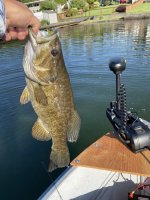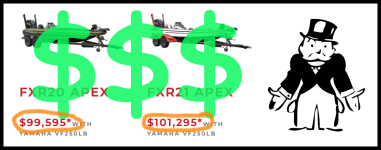Many of us who chase warm water lake fish want a bass boat. They offer a stable casting platform, storage, room for a buddy, and features like foot controlled bow mount trolling motors. But almost as many of us don’t have the cash sitting around for that kind of fancy and specialized watercraft. What many of us do have money for though, is a 12-14ft aluminum boat with a small tiller outboard. While I can’t help you with storage or room for your friends, I can help you put a bow mount motor on your little boat.
Tinnie, tinboat, runabout, tinyboat, they have many names but what they all have in common is being easily and fairly cheaply acquired. These instructions should work for anything from a 1960's Sears Gamefisher to a brand new Marlon. The boat used in this example is a 1990’s 12ft Duroboat (made here in WA, at least until they moved to TN in 2010). The motor is a Minn Kota PowerDrive and quick release plate, though the process would be virtually the same for any trolling motor. I suspect the process would be similar for a small fiberglass boat if you have one of those around, but that’s not something I have experience with.
Your design options
Unless you are lucky enough to have a boat with an existing giant bow plate, you’ll need to build a bow platform out of wood or metal for the trolling motor to be mounted to. It doesn't have to be large, just big enough for the trolling motor base, but it does need to be sturdy enough to withstand the torque that the motor will place on it. The platform will sit on top of the gunwales and be bolted to them. Though for some boats, you may end up having to bolt through the sides to create mounts for the platform to sit on inside the gunwales.
For most boats, the design will essentially be roughly a triangle or trapezoid shape. Materials can either be aluminum plate or plywood (carpet covered or not). From my research, for aluminum, it sounds like 1/4" is the way to go if you can get it. If you can’t and need to use 1/8" (which can be found most places), you’ll want to add some bracing under the non-gunwale edge of the triangle. For wood, 3/4" is probably your best option. Wood will be cheaper and easier to cut, but will eventually rot, even if you protect it. Aluminum plate can be expensive and if you don’t have tools and experience cutting/smoothing it, that’s going to be a hassle, but it will probably outlast you regardless of what weather you put it through.
I decided to go with 3/4" plywood for my platform. It was cheaper (as I already had some scrap around) and I figured that once I got it designed and built, I could easily switch to aluminum down the road by using the wood one as a template. I also simply bolted the platform to the gunwales and did not need to use side mounts or cross bracing. FWIW, I used cheap-o CDX grade ply.
Measuring the template for size.
Planning
The easiest way to start is to find a big piece of cardboard and trace the outline of the bow of your boat. Bear in mind that, depending on your bow and bow plate design, you may need to account for that in your template design. Trace back as far towards the stern as the piece of cardboard will let you, even if you won’t need a platform nearly that big. If you aren’t someone who orders everything online like me, (and thus has cardboard coming out of his… well, it’s a lot of cardboard), a good place to find big pieces is to ask a bike shop if they have any bike shipping boxes they are getting rid of.
Once you’ve traced the outline, cut it out and you should have a triangle shape that is far larger than the platform you’ll ultimately need. Next, you need to cut that triangle down to size. Lay the cardboard template on a hard surface and set your trolling motor (or QR plate) on top and position it where it needs to sit to properly deploy. Take note of where the mounting holes are as this will also be relevant to the platform size. You can also lay some plywood across the bow of your boat and place the template on top to help get your placement correct (as I've done in the photo above). Regardless of how you do it, you should end up understanding how much smaller the template needs to be. Measure, mark and trim the template down to size.
Construction
For this section, I’m going to write as if everyone was using plywood. But the steps are pretty much the same for aluminum plate.
Once you’ve gotten your cardboard template to the correct size, trace the outline onto the plywood in preparation for cutting out the bow platform. I highly encourage everyone to slow down through these steps and measure two, three, four times before cutting. Once you are ready to cut, a jigsaw will be the tool you want here just because you will be cutting on a curve for at least two of the sides of your triangle. I also would encourage cutting a little too big rather than trying to cut right on the line. You can always take material away if you need to, but you can’t add it back on. I ended up sanding the edges a bit to smooth out my less-than-perfect jigsaw line following.
Cutting the bow plate out |
Now that you have your platform, it’s time to secure it to the boat. Again, in this instance, I’m just bolting the platform to the gunwales and not adding a cross brace. I used a few hand clamps, got the platform into place and clamped it down. I then set the trolling motor into place once more and drew an outline around it (as well as marking the motor’s mounting holes). The reason I took this step is that where the motor needs to sit is going to dictate where your platform mounting bolts can be. On the side of the platform where the motor hangs over, I had to leave a pretty significant sized space, so the bolt pattern is different on each side. Once you’ve got everything marked where you want, it’s time to drill.
Preparing to drill
Drilling down from the top will be easier, but I decided to drill up from the bottom because I wanted to make sure that I didn’t mess up the gunwale bumper that surrounds my boat. I used blue painters tape wrapped around the bumper to make sure that I hit my marks. Once you’ve got your mounting holes it’s just a matter of a trip to the hardware store for the appropriate bolts and washers. As with anything boat related, go with stainless steel if you’ve got some extra cash in your pocket. Otherwise expect to replace your mounting hardware due to rust every so often, especially if you are anywhere near the salt water. Speaking of material lifespan, I know that a plywood platform won’t last forever. I didn’t go crazy trying to protect it, but I did apply a few coats of spray-on Spar Varnish. If you had some around, marine epoxy would be a much more protective option. But the cost of plywood + epoxy ends up being more than just going with aluminum from the jump. I added on a quick release bracket because my boat doesn't live in a spot where I can leave anything of value in it, so I needed to be able to pull the motor off easily. But that won't be necessary for everyone.
All mounted (except for the prop)
In use
I have had zero issues using my trolling motor on this bow platform since I finished it last summer. It works exactly as you’d expect and gives me one of the best features of a dedicated bass boat, but without the hefty price tag. Going forward, I’ve got a fishfinder I want to mount up there as well so I can be REALLY fancy. After that, all I need is a NASCAR looking fishing jersey with all my sponsors and I’ll be good to go. At some point, I suspect I’ll want to replace the plywood with aluminum plate. I could probably have gotten more time out of the wood if I’d used a nicer grade of ply and took the time to apply a stronger finish. But I knew that risk going in and accepted the tradeoff of saving money by using scrap wood and a finish I had sitting in the garage.
Additional resources
Tiny Boat Nation is a well known company around modifying small tin boats to be mini bassmasters. They have a YouTube channel with some really impressive (and expensive) builds. But I found the photos in their Facebook group to be far more helpful in trying to figure out how to build what I was looking for. Tinboats.net has been around forever and has lots of info on aluminum small boats generally.
On the water | It catches fish |
Josh, that's all just too much work...
Don't really fish for bass all that often? Don't want to shell out for a bow mount motor? Have a regular trolling motor sitting in the corner of your garage gathering dust? Allow me to introduce you to a magic device that will do almost the same thing with much less hassle:
Put a transom trolling motor on your bow - Pro Controll EZ Mount Review
Pro Controll EZ Mount Review Bow mount trolling motors are awesome. You have a much better view of the area you are fishing. They allow you to have far greater control over positioning in tight spaces. Poking around docks and other structure...


